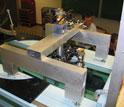News Release 09-225
On the Crest of Wave Energy
Engineers use aerospace approach to design wave energy system

View from the far downstream end into the test section of the U.S. Air Force Academy water tunnel.
November 18, 2009
This material is available primarily for archival purposes. Telephone numbers or other contact information may be out of date; please see current contact information at media contacts.
The ocean is a potentially vast source of electric power, yet as engineers test new technologies for capturing it, the devices are plagued by battering storms, limited efficiency, and the need to be tethered to the seafloor.
Now, a team of aerospace engineers is applying the principles that keep airplanes aloft to create a new wave-energy system that is durable, extremely efficient, and can be placed anywhere in the ocean, regardless of depth.
While still in early design stages, computer and scale-model tests of the system suggest higher efficiencies than wind turbines. The system is designed to effectively cancel incoming waves, capturing their energy while flattening them out, providing an added application as a storm-wave breaker.
The researchers, from the U.S. Air Force Academy, will present their design at the 62nd annual meeting of the American Physical Society's Division of Fluid Dynamics on Nov. 24, 2009, in Minneapolis, Minn.
"Our group was working on very basic research on feedback flow control for years," says lead researcher Stefan Siegel, referring to efforts to use sensors and adjustable parts to control how fluids flow around airfoils like wings. "For an airplane, when you control that flow, you better control flight--for example, enabling you to land a plane on a shorter runway."
A colleague had read an article on wave energy in a magazine and mentioned it to Siegel and the other team members, and they realized they could operate a wave energy device using the same feedback control concepts they had been developing.
Supported by a grant from the National Science Foundation, the researchers developed a system that uses lift instead of drag to cause the propeller blades to move.
"Every airplane flies with lift, not with drag," says Siegel. "Compare an old style windmill with a modern one. The new style uses lift and is what made wind energy viable--and it doesn't get shredded in a storm like an old windmill. Fluid dynamics fixed the issue for windmills, and can do the same for wave energy."
Windmills have active controls that turn the blades to compensate for storm winds, eliminating lift when it is a risk, and preventing damage.
The Air Force Academy researchers used the same approach with a hydrofoil (equivalent to an airfoil, but for water) and built it into a cycloidal propeller, a design that emerged in the 1930s and currently propels tugboats, ferries and other highly maneuverable ships.
The researchers changed the propeller orientation from horizontal to vertical, allowing direct interaction with the cyclic, up and down motion of wave energy. The researchers also developed individual control systems for each propeller blade, allowing sophisticated manipulations that maximize (or minimize, in the case of storms) interaction with wave energy.
Ultimately, the goal is to keep the flow direction and blade direction constant, cancelling the incoming wave and using standard gear-driven or direct-drive generators to convert the wave energy into electric energy. A propeller that is exactly out of phase with a wave will cancel that wave and maximize energy output.
The cancellation will also allow the float-mounted devices to function without the need of mooring, important for deep-sea locations that hold tremendous wave energy potential and are currently out of reach for many existing wave energy designs.
While the final device may be as large as 40 meters across, laboratory models are currently less than a meter in diameter. A larger version of the system will be tested next year at NSF's Network for Earthquake Engineering Simulation (NEES) tsunami wave basin at Oregon State University, an important experiment for proving the efficacy of the design.
Reporters interested in attending the 62nd Annual Meeting of the American Physical Society's (APS) Division of Fluid Dynamics can register for free. The conference takes place from Nov. 22-24, 2009, at the Minneapolis Convention Center. The conference is the year's largest devoted to fluid dynamics, bringing together researchers from across the world and across a wide range of disciplines.
The talk, "Deep Ocean Wave Cancellation Using a Cycloidal Turbine" by Stefan Siegel, Tiger Jeans, and Thomas McLaughlin of the U.S. Air Force Academy is at 12:06 p.m. at Tuesday, Nov. 24, 2009. The abstract is at this link.
All meeting information including directions to the Convention Center are here. A PDF of the meeting abstracts can be viewed at this link.
If you are a reporter and would like to attend, please contact Jason Bardi (jbardi@aip.org; 301-209-3091).
The APS Division of Fluid Dynamics Virtual Press Room, including a multimedia gallery, will contain news tips as well as high-resolution animations and still graphics, and papers detailing results presented at the meeting.
-NSF-
-
Cycloidal turbine installed on top of the test section of the U.S. Air Force Academy water tunnel.
Credit and Larger Version -
A cycloidal turbine prototype with three blades is shown.
Credit and Larger Version
Media Contacts
Joshua A. Chamot, NSF, (703) 292-7730, email: jchamot@nsf.gov
Jason Bardi, American Institute of Physics, (301) 209-3091, email: jbardi@aip.org
John Van Winkle, U.S. Air Force Academy, (719) 333-7593, email: John.VanWinkle@USAFA.af.mil
Program Contacts
Dagmar Niebur, NSF, (703) 292-8339, email: dniebur@nsf.gov
Principal Investigators
Stefan Siegel, US Air Force Academy, (719) 333 9080, email: stefan.siegel.ctr.de@usafa.edu
Related Websites
Breakup of a Jet of Liquid in the Wind: http://ecommons.library.cornell.edu/handle/1813/14132
Simulating a Jellyfish's Movement: http://ecommons.library.cornell.edu/handle/1813/14080
The U.S. National Science Foundation propels the nation forward by advancing fundamental research in all fields of science and engineering. NSF supports research and people by providing facilities, instruments and funding to support their ingenuity and sustain the U.S. as a global leader in research and innovation. With a fiscal year 2023 budget of $9.5 billion, NSF funds reach all 50 states through grants to nearly 2,000 colleges, universities and institutions. Each year, NSF receives more than 40,000 competitive proposals and makes about 11,000 new awards. Those awards include support for cooperative research with industry, Arctic and Antarctic research and operations, and U.S. participation in international scientific efforts.
Connect with us online
NSF website: nsf.gov
NSF News: nsf.gov/news
For News Media: nsf.gov/news/newsroom
Statistics: nsf.gov/statistics/
Awards database: nsf.gov/awardsearch/
Follow us on social
Twitter: twitter.com/NSF
Facebook: facebook.com/US.NSF
Instagram: instagram.com/nsfgov




